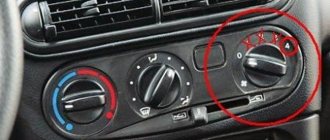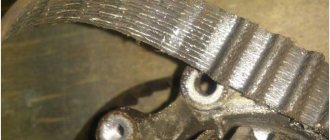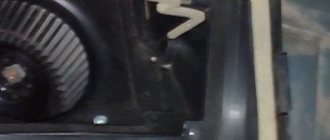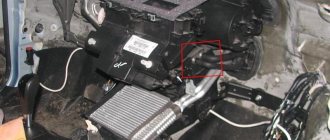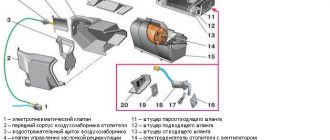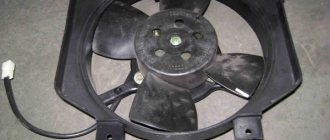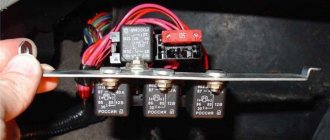The main reason why you have to change the heater motor on a VAZ 2110-2112 is the appearance of a rather unpleasant sound - a squeak, a squeal, call it what you want. In general, when the heater fan on your car starts to squeak, even lubricant in most cases cannot solve this problem. As a result, the only reliable solution is to completely replace the heater motor.
This work, of course, is not fast, but in principle, you should not have any special problems when performing it. On VAZ 2110-2112 cars there are two types of interior heater - old and new. So, in this article we will consider an example using an old-style stove, since my car is manufactured in 2002.
Problem solving
Now let's talk about how to solve emerging issues, troubleshoot problems and return the heater to normal operation.
Each breakdown requires separate consideration.
Broken motor
Temperature not regulated
If the temperature of the air flows cannot be adjusted, the problem is hidden in the control unit or damper, or the temperature sensor on the ceiling inside the cabin does not work.
To check, turn the regulator all the way to the right and place your hand under the air flow. If warm air flows only when the regulator is in the maximum heating position, change the sensor. If that doesn't help, change the regulator. If heat is received in other positions of the regulator, the sensor should not be blamed.
Be sure to check that the damper is not stuck. It can be accessed through the engine compartment. If replacement is necessary, replace the standard plastic damper with an aluminum product. It is more durable.
Blowing cold
If the heater on your VAZ 2110 starts blowing cold air, you need to look for the reasons. The cause of the failure lies in the gear motor. A similar situation occurs in 9 out of 10 cases, so it is unlikely that you will have to look for alternative culprits.
Air flows with a broken damper
The gearmotor needs to be replaced. This is done as follows:
- Wipers are removed;
- The frill is dismantled;
- Unscrew the three screws that hold the gearmotor;
- The wiring is disconnected;
- A new one is installed in place of the failed device. Ask your assistant to switch the position modes of the regulator, and at this moment you will mount the gearmotor;
- The frill and wipers are returned to their place. Work is done.
But there is 1 case out of 10 that will force you to change the heater due to wear and tear of the old one. As the practice of VAZ 2110 owners shows, the heater from 2112 is best suited for replacement. Moreover, you can choose between two stove options - 2112-01 or 2112-02. The first one does not have an air filter, while the second option has one.
The windows fog up, the feet are not heated
It is not uncommon for VAZ models to have a problem when air flows normally from the stove, but it does not heat the feet and does not flow onto the windows.
Modification of air ducts
The issue can be resolved by upgrading your air ducts and getting rid of existing gaps in the cabin and warm air intake channels. This is a rather complicated procedure, the implementation of which will allow you to forget for a very long time about the problem with the stove, which does not warm your feet and does not blow on the side windows.
It would not be superfluous to install a pre-start heater. Due to it, the interior warms up faster.
Coolant leaks
The stove may not heat up due to the fact that the level of coolant, that is, coolant, decreases. Do not rush to add antifreeze to the tank. First, be sure to check for signs of leakage in the pipes and connections.
Problems with the stove on a VAZ 2110
If your radiator is leaking, the news is not good for you. You will have to dismantle it and, most likely, replace it with a new one.
The heater is very noisy
Many owners of the domestic “ten” are faced with a situation where a working stove makes a lot of noise. In this case, everything works fine, air flows spread throughout the cabin in the same way as the regulators are set.
The noise does not affect efficiency, but it becomes seriously annoying over time. Sometimes it seems that the stove will be covered with a copper basin, although it can make noise for a long time without consequences for the integrity of the device.
Let's try to figure out why it makes noise.
- If the noise is similar to a squeal, or the sounds are sharp, check the fastening of the lower part of the stove. The fact is that fastening is carried out using hooks that can come off. This is what makes the noise.
- The heater body sometimes gets damaged by the protrusions holding the retainer. In this case, the housing simply needs to be replaced with a new one.
- If the fan itself is noisy, remove it, clean it, and check the condition of the electric motor.
- The textolite washers, which are designed to prevent axial play of the fan, may also hum. Any low friction washers will be suitable as a replacement. For example, elements made of fluoroplastic. Be sure to lubricate the washer. Some people use regular machine oil, but it really only gives a temporary effect. The best lubricant in this case would be thick graphite grease or lithol.
The stove releases cold air
The first thing to do is to determine the cause of the breakdown. This will help you find ways to solve it. But there are quite a lot of them, so let's look at the most popular ones.
One common reason is that only cold air comes out of the unit. This is the first sign that the stove is not working properly. The reason lies in the fact that the interior temperature sensor has broken down - it is responsible for what conditions are in the cabin and whether they correspond to those set by the driver. If it fails, then its readings are incorrect. Thus, the stove receives information that it is hot in the cabin. It will therefore produce cold air to make conditions more comfortable.
It's easy to fix this problem. There are several steps you need to take. First, remove the lampshade by unscrewing it. Then install a new sensor and check it for serviceability.
In this case, care must be taken not to reverse the polarity. Otherwise, the device will not work properly.
Also, the reason that cold air comes out of the stove can be a breakdown of the gear motor. To determine it, you must first check the temperature sensor for serviceability. If everything is in order with the latter, then clearly the problem lies in the gearmotor. It is worth noting that this part, like the previous one, cannot be repaired. The only way to solve the problem is to replace it with a new one.
This process is a little more complicated. It consists in carrying out the following actions. First, the wipers are removed. Then you need to unscrew the bolts that are responsible for fastening the frill and remove it so that it does not interfere. Thus, access to the element that has failed will be obtained.
Then you need to remove the gearmotor itself. To do this, its fastening is unscrewed. A Phillips screwdriver will help with this. Next, you should carefully disconnect all the wires. This should be done as carefully as possible so as not to damage anything. This is the only way you can completely dismantle the broken part. Using the same principle, but in reverse, install a new element. At the same time, make sure that the cut of the part clearly fits into the damper.
Principle of operation
The operating principle of such a control system is simple - the driver uses the left handle to set the desired temperature (completely cold or in the range from 16 to 28 degrees). Based on the set mode, the controller supplies power to the micromotor gearbox and it sets the dampers to the desired position.
Two-way communication is used between these elements - a position sensor is installed on the gearbox, which “informs” the controller about the opening angle. Thanks to the installed temperature sensor (located on the ceiling), the controller constantly monitors the degree of heating of the air in the cabin, based on which it adjusts the position of the damper to maintain the temperature set by the driver.
Temperature sensor VAZ 2110
Thanks to the use of automatic control system, the driver no longer needs to adjust the operation of the stove in order to maintain a comfortable temperature; he sets the temperature with a handle, and the controller does the rest. On the early VAZ-2110, the heater fan had three operating modes, the difference between which comes down to the rotation speed. Speed adjustment is carried out by installing a rheostat block in the power supply circuit of the electric motor. Then models appeared in which the fan received a 4th operating mode - automatic. When it is turned on, the fan operates under the control of the controller - the ACS regulates the rotation speed of the electric motor to adjust the temperature in the cabin.
The use of electromechanical control on the VAZ-2110 increased the convenience of controlling interior heating, but due to the more complex design, the likelihood of stove failure increased.
How to check the cabin air temperature sensor?
To check whether the air temperature sensor on the ceiling has failed, you should take out its ends and apply a voltage of 1.2 V to the plus and minus terminals. In this case, if you set the controller knobs of the automatic heater control system to the “MIN” and “MAX” positions at the corresponding points (blue and red), then the fan should not rotate. Also, when the automatic control system is working, you can try to disable the cabin air sensor; in this case, mode “A” of the fan speed should stop working.
How to check the heater damper micro-reducer
To test the micro gearbox, you must use an ohmmeter. On older versions of SAUO controllers, the minimum resistance should be in the range from 800 to 1,200 Ohms. In new samples this figure is 3.5–5 kOhm. Set the minimum mark on the heater control unit and wait 15 seconds. Next, simply disconnect the controller connector, measure the resistance between contacts X1.4 and X1.1.
When the temperature is set to the maximum level, the multimeter should output 3.2–5 kOhm, taking into account the fact that an old version of the controller is used. On the new one the indicator is 1.2–1.6 kOhm. If the indicators do not change, it means that the micro-gearbox shaft position sensor on the VAZ is faulty. In this case, take the car to a service center, as the replacement process requires the intervention of a professional. If you want to carry out the replacement yourself, carefully follow safety precautions.
There is no need to rush, as careless handling of spare parts can damage other components, which in turn will lead to even greater expenses and a mandatory visit to a service station. It is also recommended to purchase only high-quality equipment, because used spare parts can quickly become unusable and fail you at the most inopportune moment.
How to check the serviceability of the SAUO controller
To check the automatic control system, you will need a multimeter to measure the voltage on the pink and brown wires (turn on the ignition and turn the temperature knob). Depending on which controller is installed on the car, the voltage changes differently. On cars before 2001, a heater control controller 1303.3854 was installed; its voltage in the “min” position decreases after 13 ± 5 seconds, and is constantly supplied to o. Thus, when the output voltage of the ACS unit does not change, it is not working. On cars after 2003, block 1323.3854 and stove 2111-8101012 were installed.
When the controller malfunctions, the dampers may not work , but in order to diagnose other causes of malfunction of the VAZ 2110-12 heater, you will have to disassemble the heater.
Carrying out repair work at SAUO
Note. Before you begin repair work on the self-propelled control system, you must make sure that the problem with the furnace malfunction lies in the controller.
VAZ 2110 stove controller
In order to make sure that the furnace controller is really in good condition, you need to replace its non-working version with a working one, having first taken a working controller from a store or from a friend, comrade, etc. If the problem is not in the controller, then you need to contact a service center for professional diagnostics and troubleshooting.
Note. You should never rule out other options for furnace malfunction.
The above information and instructions will be useful only if they are reinforced with the help of photos and video materials, since they, in combination with theoretical information, will help to correctly present the picture of what is happening. The advantage of diagnosing a controller replacement with your own hands is, first of all, the price, and the advantage of a car service is professionalism.
Adjusting the automatic control system
To check the functionality of the device, you should take a mercury thermometer and place it near the temperature sensor. After this, you need to activate the stove controller and set the fan control knob to position “A”. The automatic control system should be carefully adjusted only if after 15–20 minutes the temperature is more than two degrees below the data from the sensor.
In order for the self-propelled gun to work better, you will have to pull it out and then turn the knob located on the left side of the controller several times. You can increase the temperature by turning the knob clockwise, and decrease it by turning it counterclockwise.
Possible causes of malfunction
Before carrying out repairs, you should carefully study the possible causes of a malfunction of the car heater fan:
- Burnt fuse. The real reason is the most banal and simple, but at the same time it is the one that leads to the greatest problems in solving the existing issue. Replacing a fuse turns out to be a very simple procedure that any motorist can successfully handle. Despite simple repairs, it is extremely difficult to detect the short circuit that led to the blown fuse.
- Oxidation of contacts that should be used to establish the operation of a car heater.
- The ignition relay does not allow the heater to turn on and start working successfully.
- An additional resistor can result in only the third speed being operational.
- A faulty car interior heating switch requires replacing the fuse.
- A non-working electric fan motor is another important reason. In this case, it is necessary to replace the heater motor or at least check its contact with the vehicle. In most cases, the cause is hidden in a burnt-out electric motor, poor contact with the machine, or sticking electric motor brushes.
Regardless of the cause of the malfunction, you can successfully adjust your car heater
The most important thing is to understand what exactly is the cause of the breakdown or partial disruption of the functionality of the heating equipment
If diagnostics have confirmed that the cause lies in the heater motor, replacing the heater fan most often becomes a mandatory task. How to carry out such a responsible procedure and how easy does it promise to be?
The radiator fan on the VAZ-2114 is used to forcibly cool the engine and cooling system when natural cooling is insufficient. It turns off especially often if the temperature sensor is broken.
Its failure can lead to unexpected consequences, therefore, it is necessary to determine the cause of the malfunction in a timely manner and eliminate it. If the motorist is unable to do this, then it is worth contacting a car service center.
Throw off the » — » battery cable to replace the fan of the VAZ 2110 stove
2. Disconnect the “+” connector of the heater fan wires
3. Using a ten key, unscrew the nut...
4...and remove the negative wire.
5. Use a screwdriver to unfasten the four brackets...
6. carefully bending the lid,
7. Remove the stove fan and replace it with a new one if it is not possible to repair it.
When installing the electric motor, make sure that it does not touch the housing when rotating.
Selection and installation of the VAZ 2110 stove motor
The next step is to purchase and install a new fan motor for the furnace. The price of a new engine can be about 1,500 rubles. Before installing a new motor in the stove, you must first make sure it is working properly.
If the purchased motor is in working order, then you should begin installing it in the stove. And the next step will be to reassemble the stove and install it in the car.
As you can see, the procedure for replacing the stove motor is very simple to perform and does not require a large investment of time and money. This procedure can be done independently in the garage without contacting third-party car services. The price of such work in the service can range from 300 to 600 rubles.
Source
Heater fan not working
It is quite simple to understand that the car's heater fan is faulty. To do this, just start the car and switch the heater operating mode. If during the switching process no additional sounds appear in the vehicle interior, this means that the heating system fan is not working. At the same time, if the fan does not spin only at certain speeds, then the problem is not in the fan itself, but either in the resistor or in the heating intensity toggle switch.
The stove fan does not work - the main reasons
There are six main reasons why the stove fan may not work:
1. The fuse has blown.
This is the most banal and simple reason, but at the same time the most problematic. The thing is that replacing a fuse is a very simple procedure that anyone, even the least experienced car owner, can handle. But it’s very difficult to identify the short circuit that caused it to burn out. To do this, you will have to go through the entire electrical circuit of the car's interior heating system.
Video. The fan on the VAZ 2110 does not work
It is worth noting that the fuse marked F7, which has a current strength of 30 amperes, is responsible for the operation of the stove. Note that the same fuse is responsible for the glove compartment lighting, the cigarette lighter, the rear window heating system, as well as the electric headlight washer motor. This means that if you do not find the cause of the short circuit in the electrical circuit of the heater, you will have to go through almost the entire wiring of the vehicle.
2. Poor quality contact inside the mounting block.
Oxidation of the contacts inside the mounting block is a very common cause of stove fan malfunction. To make sure of this, you need to move the block on which the flagella are attached; if the fan starts working, then remove it and clean the contacts.
3. Flooding the relay of the vehicle ignition system.
This problem is diagnosed quite simply. If your heater starts working only after the car has “warmed up”, then the reason is in the ignition relay. The only way to fix this problem is to replace the relay. It is located under the dashboard.
4. The stove only works at third speed.
In this case, the problem is related to the additional resistor. The thing is that at speeds 1 and 2, electric current is supplied to the fan through a resistor, and at speed 3, it is supplied to it directly. There is only one solution in this case - replacing the additional resistor of the heating system of the car interior.
Let us recall that in the previous article we looked at how to replace brake fluid with your own hands. This process must be performed regularly, according to the manufacturer's recommendations.
5. The vehicle interior heating system switch is faulty.
To check this switch, you should dismantle the center console, start the car, take a 12-volt marker light bulb with soldered wires and short the negative wire from it to the body, and touch the second to contacts 1, 2 and 3 of the additional resistor. If the light bulb is on, then the switch is working, and if not, then connect the wire of the light bulb to the positive terminal of the switch. If it does not light up, then the culprit is an open circuit or a blown fuse.
6. The electric fan motor does not work.
When you have checked all the previous options, but have not identified any problems, then there are only three reasons why the stove fan does not spin: - the electric motor has burned out - the electric motor has poor contact with the ground of the car - the brushes of the electric motor have become stuck.
Preparation
Preparatory activities do not include many complex operations. You will need to do the following:
- Remove the negative terminal from the battery to de-energize the car and protect the car from possible short circuits;
- Drain the coolant from the system. To do this, open the cap of the expansion tank to relieve excess pressure, and then unscrew the drain. The liquid must be drained into a special prepared container.
When draining the cooling liquid, one important rule must be observed - the procedure is carried out only when the engine has cooled down. If in the future you are going to use the same antifreeze or antifreeze, then choose a clean container for draining. If in the future you are going to use the same antifreeze or antifreeze, then choose a clean container for draining
If in the future you are going to use the same antifreeze or antifreeze, then choose a clean container for draining.
Fan replacement
If the problem still lies in the fan itself, then it would be best to replace it with a new one. The stove fan can, of course, be repaired, but this may involve, for example, replacing the brushes. It simply doesn’t make sense to carry out more comprehensive repairs, since you can’t hope for long-term service for such a part. Replacing a VAZ-2110 stove fan requires selecting a new part. There are two options here: find an old-style part or buy a new spare part. The second option is more acceptable and accessible.
VAZ stove fan
The replacement process is not as complicated as it might seem. It is enough to be able to work with standard tools, have free time and have the desire to tinker with your own machine. To replace a faulty fan, you must follow the following work plan:
- Open the hood and remove the battery negative terminal.
- We remove the windshield wipers by prying and dismantling the rubber caps. Using a 10mm wrench, unscrew the nuts and remove the brushes.
- Using a slotted screwdriver, pry up the decorative plugs, unscrew the screws on the frill and the nuts on the edges. Now we can remove the frill.
- Under the rubber seal you can find screws that hold the shield from the engine compartment. We also unscrew them.
- We dismantle the hose through which washer fluid is supplied to the injectors.
The process of replacing a fan is not as complicated as it seems
- On the right side of the engine compartment, there are two nuts on the bottom side that fit a 10mm socket wrench. They are difficult to get to, but you don’t have to unscrew them all the way, because with a few turns the shield can be easily removed.
- It is necessary to remove the clamps from the hose that connects to the vacuum booster of the brake system in advance.
- There are four self-tapping screws on the cabin filter cover; after unscrewing them, you can easily remove it.
- Already at this stage the outlines of the stove motor are visible. But you will also need to disconnect the block on the heating system motor and on the resistor.
- After the work has been done, it becomes possible to dismantle the left side of the stove along with the motor.
- A new part is installed in place of the damaged element, and assembly is carried out in the reverse order.
If you have never had to remove a heating system fan before, this process may take several hours. But in the future, any problem with the heating system can be fixed much faster. Even if something doesn’t work out for you during your work, you don’t need to stop trying to achieve a positive result. Over time, everything will definitely work out.
How to prepare for the event
If you need to repair a VAZ stove fan, you need to make sure you have the necessary tools:
- head 10 millimeters, deep;
- Phillips screwdriver (2 varieties: regular and short);
- ratchet with extension.
Only if all the tools are available can the main activities be carried out. Of course, for a successful result, at least minimal experience with wrenches and screwdrivers is required. If there is no relevant experience, the task at hand becomes significantly more difficult.
Checking the dampers of the VAZ 2110 heater system
The stove system has 2 dampers. The upper one regulates the intake of cold air, and the lower one regulates the intake of hot air from the heater radiator. And when the drive mechanism or the damper itself breaks down, the stove can heat weakly, not heat at all, or fry too much.
Breakdowns of the stove damper can be of different types; firstly, the damper often gets stuck or jams, and secondly, the damper drive (micromotor-reducer) fails. In some cases, the damper warps or jams due to rust, since there are two types of dampers: the old and the new type, the old ones are plastic with a foam rubber seal, and the new one is metal with a rubber seal. Therefore, if you cannot hear the damper moving, you can move it by hand by removing the deflector in the central panel. The problem with metal ones is that they often jam from rust, and plastic ones warp from exposure to hot air. So if, for example, warm air blows into the front window of a VAZ 2110, and hot air blows from the sides and into the legs, then most likely the damper has not completely blocked the air intake from the street. And when the dampers do not move at all, then you need to check the microdetector - the damper drive mechanism.
Heater fan not working
It is quite simple to understand that the car's heater fan is faulty. To do this, just start the car and switch the heater operating mode. If during the switching process no additional sounds appear in the vehicle interior, this means that the heating system fan is not working. At the same time, if the fan does not spin only at certain speeds, then the problem is not in the fan itself, but either in the resistor or in the heating intensity toggle switch.
The stove fan does not work - the main reasons
There are six main reasons why the stove fan may not work:
1. The fuse has blown.
This is the most banal and simple reason, but at the same time the most problematic. The thing is that replacing a fuse is a very simple procedure that anyone, even the least experienced car owner, can handle. But it’s very difficult to identify the short circuit that caused it to burn out. To do this, you will have to go through the entire electrical circuit of the car's interior heating system.
Video. The fan on the VAZ 2110 does not work
It is worth noting that the fuse marked F7, which has a current strength of 30 amperes, is responsible for the operation of the stove. Note that the same fuse is responsible for the glove compartment lighting, the cigarette lighter, the rear window heating system, as well as the electric headlight washer motor. This means that if you do not find the cause of the short circuit in the electrical circuit of the heater, you will have to go through almost the entire wiring of the vehicle.
2. Poor quality contact inside the mounting block.
Oxidation of the contacts inside the mounting block is a very common cause of stove fan malfunction. To make sure of this, you need to move the block on which the flagella are attached; if the fan starts working, then remove it and clean the contacts.
3. Flooding the relay of the vehicle ignition system.
This problem is diagnosed quite simply. If your heater starts working only after the car has “warmed up”, then the reason is in the ignition relay. The only way to fix this problem is to replace the relay. It is located under the dashboard.
4. The stove only works at third speed.
In this case, the problem is related to the additional resistor. The thing is that at speeds 1 and 2, electric current is supplied to the fan through a resistor, and at speed 3, it is supplied to it directly. There is only one solution in this case - replacing the additional resistor of the heating system of the car interior.
Let us recall that in the previous article we looked at how to replace brake fluid with your own hands. This process must be performed regularly, according to the manufacturer's recommendations.
5. The vehicle interior heating system switch is faulty.
To check this switch, you should dismantle the center console, start the car, take a 12-volt marker light bulb with soldered wires and short the negative wire from it to the body, and touch the second to contacts 1, 2 and 3 of the additional resistor. If the light bulb is on, then the switch is working, and if not, then connect the wire of the light bulb to the positive terminal of the switch. If it does not light up, then the culprit is an open circuit or a blown fuse.
6. The electric fan motor does not work.
When you have checked all the previous options, but have not identified any problems, then there are only three reasons why the stove fan does not spin: - the electric motor has burned out - the electric motor has poor contact with the ground of the car - the brushes of the electric motor have become stuck.
Why does the heater on the VAZ-2110 not work and not blow?
One of the most problematic components in the design of the VAZ 2110 is the heating system. It claims to be complex and modern, but in reality it brings a lot of problems to its owners. To describe all the problems of a dozen heaters, it will take more than one hour, so today we will focus on the complete failure of the stove in operation and touch on the block of the automatic heater control system, SAUO, as mechanics call it in the army.
THIS IS INTERESTING: Renault Sandero heater motor replacement
The stove doesn't blow at all, what's the problem?
If the heater fails, you can do the initial fault diagnosis yourself.
Unfortunately, the complex heater control system has not proven itself as a device that allows you to take the hassle off the driver and automatically maintain the set temperature. Instead, we got a lot of trouble and cold interiors in the frost. Let's go from simple to complex and first let's look at the problems with the electric heater motor. Everything is more or less simple here:
- Fuse. We turn on the stove, it doesn’t work. If we were lucky, the fuse had blown. Finding it is as easy as shelling pears, it is more difficult to find out the reason for its burnout. The 25-amp fuse F18 is located in the main mounting block; it also protects the circuit for the glove compartment lighting, heated rear window and is partially related to the cigarette lighter, so it is easy to diagnose its failure. And in order to find the short circuit that caused it to burn out, you will have to call all these circuits - the glove compartment light, the rear window heating, the headlight washer and the cigarette lighter. Heater fuse location.
- Contacts. A very common occurrence on the VAZ 2110 is the lack of contact on the heater control unit or on the electric motor itself, there is no contact on the power wire on the automatic control system. You will have to go through and clean all these contacts. We check the contacts on the heater control unit and the electric motor.
- Stove blower. The electric motor of the stove also does not last forever and can either simply burn out or fail for another reason. To check its operation, we get to its power supply contacts and measure the voltage. If we record 12 V at the engine input, the problem is in the engine. The brushes may be worn out or burnt, the motor commutator may have burned out, or the winding may have burned out or shorted out. In any case, no one will bother with it, we’ll just replace the electric motor with a new one.
Checking the automatic heater control system
The stove control system can also give out surprises. They consist in the fact that one of the speeds may not work, several, or only one, the most powerful, may work. At the same time, the SAUO block is not universal and is selected depending on the year of manufacture of the car:
One of the reasons for the failure of the stove may be the unit of the automatic heater control system.
- 2110-8128020-03, price 2300 rubles, used in the last ten years of production;
- 21102-8121020, price 3100 rubles, installed on cars with air conditioning;
- 2110-8128020-02, about 2 thousand, set for the first ten years of production;
- 2110-8128020-01, 1840 rubles, used on some cars before the year 2000.
Nevertheless, the design of all units is similar, only some parameters are different, and the signs of malfunction are similar for all.
The heater only blows at one speed
Without dismantling, you can diagnose a breakdown if the fan spins only at one speed or only in the third mode. The reason is the resistor, which is installed in the heater controller itself.
When the stove operates at only one speed, you should check the resistor.
Structurally, the switch is designed so that in the first two modes the electric motor is supplied with low voltage through a resistor, and in mode 3, bypassing the resistor. You can check this using a multimeter in resistance measurement mode.
The resistance of the first speed resistor is 0.23 Ohm, the second is 0.82 Ohm. If the spiral breaks or the contact tracks are worn, the multimeter will show infinity or a break.
Depending on the controller model, it may have three or four control positions, but the principle of operation is the same and understanding the connection diagram is not so difficult. Whatever the switch is, if speeds 1 and 2 are not working, you need to check the resistance on the switch slider. Thus, you can try to restore the heater control system or replace it with a new one as a last resort. Good luck to everyone in their search and warm cozy salons!
Minor improvements
In winter, motorists often have to drive with the heater on. Otherwise, it will be quite cold in the cabin, and the windows tend to fog up. At the same time, many car enthusiasts may be annoyed by the rattling sound when the stove is running, which is especially audible at the maximum operating mode of the stove. The problem here is in the lower panel of the heater housing. It is attached on peculiar hooks. On the one hand, this simplifies dismantling if necessary; on the other hand, these fasteners can be easily unfastened. After this, the panel begins to vibrate, causing unpleasant sounds.
To fix it, simply fasten the hooks in place. Sometimes they just break off. In this case, the only option is to replace the stove assembly.
If the stove does not heat well, then it makes sense to check how the radiator is warming up. It is necessary to remove the deflector; this is done using a slotted screwdriver. After that, start the engine and let it warm up. During this time, the radiator should heat up quite well. If this does not happen, then check the functionality of the heater valve. The reason may also be a clog in the radiator itself. It must be removed and washed. For this, it’s a good idea to use a strong solution of citric acid.
If you have a car produced before 2006, then it makes sense to install a pre-heater on it. This will allow you to quickly warm up the interior in winter. There will be no problems with installation, you will just need to purchase a heater designed for the injection “ten”.
Conclusion
. The heater fan in domestic cars is not very reliable. This is why you can so often hear the question of how to replace the stove fan on a VAZ 2110 and 2112. In fact, the work is not difficult, but due to the large number of small parts that need to be removed, the replacement can take several hours. At the same time, you should be quite careful due to the abundance of plastic parts.
Fan repair (step by step)
The disassembly technology is very simple, but proceed carefully. Since electric motor failure lies in the wear of bearings and graphite brushes, let’s consider how to replace these elements:
- Let's disassemble the electric motor. To do this, first remove the impeller, and then the two spring clamps of the motor support.
- We remove the support.
- Unscrew the screws securing the brush assembly and remove it.
- Carefully knock out the rotor.
- We clean the elements from dust and dirt.
- From the inside of the stator, carefully bend the edges of the plate holding the bearing.
- We knock out the bearing and install a new one in its place (for replacement you need bearing No. 609).
- We bend the edges of the plate back.
- We inspect the condition of the collector plates on the rotor and, if necessary, sand them with sandpaper (fine-grained).
- We replace the worn brushes with new ones (we solder the wires of the worn ones, and in their place we solder the wires of the new elements).
- We bend the stops of the brush springs (this will allow you to easily install the brush assembly in place).
- We put the rotor in place.
- We install and fix the brush assembly, having previously seated the brushes in their seats.
- We install brush springs into the holes that covered the stops and bend the stops back.
- Install the fan support and impeller.
- We install the repaired fan on the car.
As you can see, it is not difficult to repair the VAZ-2110 heater fan, and this task can be handled in a garage, even without special skills in car repair.
We often find out about the stove not working with the arrival of cold weather (this can be either mechanical or electronic breakdowns).
To deal with the main malfunctions, first you need to study the design of the “tenth generation” Lada heating system and the very principle of operation of the stove.
We have identified five main reasons why the stove does not work on a VAZ 2110:
- The temperature is not regulated or the stove operates at one speed;
- The dampers distributing air flows do not work;
- The cabin temperature sensor (mounted on the ceiling) fails;
- Malfunction of the ACS controller;
- Antifreeze leaking from the heater radiator.
Replacement of the heater motor (fan) of VAZ 2110, 2112. New model. Stove repair
Rumbling, squealing, grinding, uneven rotation of the heater fan indicate the need to replace the heater motor. We go to the store and buy a new type of motor (large with three screws, manufactured since 2004). Bought in St. Petersburg for 1350 rubles. We prepare the car for work. Open the hood and remove the negative terminal from the battery. Let's start looking at:
- We remove the rubber caps from the wiper arms, use a 10mm wrench, unscrew the two nuts and remove the wiper blades.
- Using a slotted screwdriver, pry up the decorative plugs and unscrew the four screws securing the frill.
- Using a 10 mm socket wrench, unscrew the two nuts securing the frill at the edges.
- Remove the rubber seal and unscrew the screws securing the engine compartment shield from the frill.
- Disconnect the rubber hose for supplying washer fluid to the injectors.
Stove fan
Structurally, the fan consists of a DC electric motor with a commutator-brush assembly and an impeller mounted on the electric rotor. motor. The electric motor is powered from the vehicle’s on-board network. There are several modes of fan operation, the difference between which comes down only to the rotor rotation speed, and this is realized by inserting a resistor into the power supply circuit of the electric motor.
The fan operating mode is set using a handle located in the heater control unit on the center console. Initially, on the VAZ-2110, this handle was part of the design of the SAUO controller, but functioned separately from the controller itself. Later, the ACS added an automatic fan control function (position “A” on the handle), using which the controller regulates the rotation speed of the electric motor in order to maintain the set temperature.The electric motor used in the design of the VAZ-2110 fan is simple, but it has “weak points” - the commutator-brush assembly and bearings. Wear of these elements causes incorrect operation and complete inoperability of the fan. Short circuits and winding breaks in the stove drive are rare, but don’t forget about these breakdowns either.
Symptoms of failure. Heater components that affect fan operation
Signs of a malfunctioning stove fan are quite obvious and impossible not to notice. Common symptoms of failure:
- Increased noise, grinding noise during operation.
- Significant reduction in air injection efficiency.
- The fan does not turn on.
- Spontaneous change in the rotation speed of the electric motor.
- It can be determined by ear that the electric motor is operating under heavy load.
In some cases, such consequences result from malfunctions in the power supply and fan control circuits, so you should check them first. This applies to:
- fuse (blowout is the cause of complete failure of the electric motor);
- resistor (if it is faulty, some speed modes of the electric motor stop working);
- controller (the knob for switching fan modes is part of its design, so malfunctions of the automatic control system affect the functioning of the electric motor);
- wiring terminals of the power and control circuits (oxidation, damage to wires is one of the reasons for a malfunctioning electric fan).
If diagnostics of these elements shows that they are in good working order, it is necessary to dismantle and repair the fan itself. But it can be diagnosed first.
Fan check
A check is done by directly powering the electric motor from the battery (we lay wires from the battery terminals and connect them to the power terminals of the motor) - operation under load, difficulty in gaining rotation speed, squeals and squeaks indicate wear of the drive components and the need to replace them. But if, even with direct voltage supply, the electric motor does not start, it is most likely that it has burned out or the windings have broken. Such faults are difficult to fix and it is easier to replace the entire unit.

